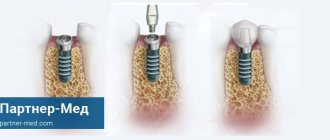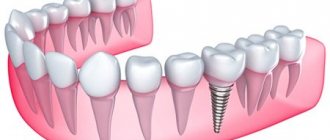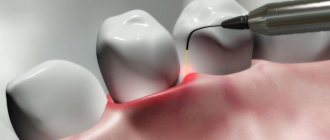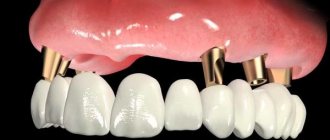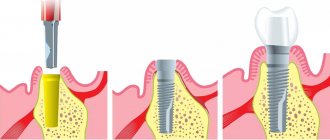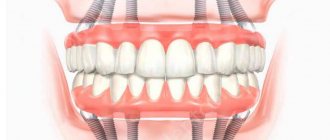1914
Implantation in dentistry is one of the fastest growing areas related to artificial dental restoration.
Huge financial resources are being invested all over the world in the development of new technologies and materials, and new projects are constantly being opened.
The result of this work is high-quality assistance to each person in eliminating their problems, based on clinical, anatomical and financial capabilities.
Purpose
Implantation is considered a complex dental operation, and in order for it to be successful even in the most severe cases, a specialist can use a template during its implementation.
This is a special type of device for a specialist, allowing him to accurately position the location of the implant, its angle of inclination, the depth of implantation, and eliminate any error.
The device greatly simplifies the doctor’s work and helps to calculate all the nuances of the operation even at the stage of planning the operation. The likelihood of complications developing during implantation and after its completion is excluded.
The use of a sample allows for manipulation with minimal trauma, since the surgeon does not make unnecessary incisions.
The template is made individually for a specific patient using a scan of the impression taken during the examination. In appearance, it is a special mouthguard with holes that are designed to accurately indicate the places where implants will be implanted.
The device very accurately follows the shape and curve of the jaw , resulting in a fairly tight fit to the gum and no errors during drilling. Materials such as a polymer component, plastic or acrylic can be used in manufacturing.
What are the positive aspects of using a template for a patient:
- The invasiveness of the operation is significantly reduced; the implantologist does not need to make incisions; he pierces the gum in the place marked in the template. After such an intervention, healing occurs much faster and more painlessly. The likelihood of postoperative swelling is reduced.
- The operation time is reduced, since the doctor does not need to mark places for installing implants. All this has already been done on the template with high accuracy.
- The prognosis for implantation success is much higher due to the fact that the position of the implants is determined with the most accurate calculation down to the millimeter. The risks of installing implants in the wrong position due to human factors are eliminated.
- It is possible to install a temporary orthopedic structure on the day of surgery.
Indications
Using a template guarantees almost 100% implantation success. It becomes necessary in the following cases:
- Difficult implantation with complete edentia , when it is necessary to install several implants at once.
- Bone tissue atrophy , when the template helps to accurately place the structure in the place on the jaw that will withstand the load without plastic surgery.
- An operation with immediate loading , when immediately after implantation of the implant a temporary crown is placed on it.
- Carrying out prosthetics on 4 or 6 implants , i.e. using all-on-4 or all-on-6 protocols.
- High demands on aesthetics , i.e. when implantation is performed in the frontal area of the dentition.
- The need for drilling at a large angle of inclination.
- Needs for non-flap surgery.
- It is planned to install a conditionally removable or non-removable beam structure.
Pros and cons of two-stage dental implantation, indications for its implementation.
Read here all the most important things about express dental implantation.
At this address https://www.vash-dentist.ru/implantatsiya/metodiki/transgingivalnaya.html find out what transgingival implantation is.
Implants, DENTAL IMPLANTATION NEW LEVEL OF PROSTHETICS
Accordingly, the task that largely determines overall success is the precise positioning of implants.For subsequent work to be successful, the technician and the orthopedic surgeon must help the surgeon identify the location where the implant will be located. If it is, for example, a removable or conditionally removable beam structure, then the correct choice of its installation location becomes a critical factor. It is necessary to understand that often the installation of an implant does not correspond to the position where the tooth will be located.
Sometimes it happens, rather, on the contrary - if we talk about a beam structure, then first the optimal places are selected that are capable of bearing the load and are favorable for this. If we talk about areas where aesthetic requirements are high, for example, about the frontal group of teeth, then you need to accurately calculate in what position and with what inclination to install the implant. In this situation, even the angle of inclination often plays a decisive role. If the shaft exits, for example, on the vestibular surface, such a result is unlikely to be satisfactory.
In addition to the inevitable problems with the aesthetics of the frontal region, in this situation, unfavorable angulation also arises - and if its value exceeds 20°, then such a solution a priori cannot be considered successful.
Thus, the use of templates when performing plantation is not something “superfluous”, since the work does not end with this stage - then it is necessary to make an orthopedic structure, which, if the implant is positioned correctly, will also be more successful.
Today there are computer methods for making templates, but if we are talking about minor surgical operations - usually the installation of two or three implants - then there is probably no point in using such expensive and complex technologies, since a template can be made in no more than half an hour in the most ordinary laboratories. However, there is one “subtlety” - in order to make a template, you need to clearly understand the design of the future work, and this requires a team approach.
A preliminary meeting is held collegially with the participation of a technician, an orthopedist and a surgeon. At this stage, a decision is made on what exactly we want to get - will it be a removable, fixed or conditionally removable structure, screw fixation or, for example, individually made abutments with further cement fixation of the crowns. All these data play a decisive role in designating the implant location. And just in order to clearly indicate it, the doctor uses a template.
Contraindications
The technique is unique because the list of restrictions for its implementation is reduced to a minimum. It is suitable even for those patients who have a history of diabetes mellitus, chronic endocrine and cardiac pathologies in the stage of incomplete or complete remission (with a significant weakening or complete disappearance of the main signs of the disease).
Important! Contraindications for which surgery cannot be performed with a template are insufficient bone tissue in the area of implantation and oncology of any organ or system.
Specialists have placed restrictions in a separate group that, under certain conditions, may prevent the use of the template:
- macroglossia, which is accompanied by insufficient mouth opening and nausea;
- dense tissue structure at the implantation site;
- difficulties with fixing the device;
- implantation of an artificial root at an angle.
Material
Templates are made for each patient, i.e. individually. They can be done in a special outsourcing center equipped with high-precision equipment or in a dental laboratory.
Depending on the type of manufacturing and the material used in this process, surgical templates come in the following types:
- Acrylic. In their production, a polymer is used - acrylic mass.
They are made in the laboratory in the image of a removable prosthetic structure. An impression is made in the clinic, a technician is sent to the laboratory, a model is cast, from which a template will then be made. Acrylic products are most often used in dental practice because they are affordable. - Transparent. The product is made of special transparent plastic in a vacuum former, therefore it is practically invisible. Today it is used extremely rarely due to the softness of the material, but this quality does not affect elasticity, stability and strength.
- Plastic. They use a medical polymer, which is characterized by a high degree of stability, strength, and rigidity.
- Templates made using CAD/CAM methods using digital modeling. The devices are manufactured using high-precision equipment.
An impression of the patient's jaw is taken, which is further processed on a digital scanner. Afterwards, all data is sent to a computer, where the program carries out step-by-step planning of the operation, selects the parameters of the implants, determines their implantation sites and angles of inclination.The prepared calculations are transferred to the machine for making the template. This type is rarely used, since the use of high-precision equipment in its manufacture increases the final cost.
Important! Regardless of the material and manufacturing method, each of the templates is securely fixed in the oral cavity, easy to use, and allows for easy and precise implantation.
Kinds
For implantation, a dental surgeon can use one of three templates:
- Bone supported .
The product is modeled using a 3D sample using a computed tomograph. The manufacturing process itself takes place on stereolithography equipment. Of all the types, this design is the most accurate because it rests on the bone. But at the same time, the surgical technique involves peeling off a large area of tissue, which increases the duration of the postoperative period. - Based on nearby teeth, and there should be 2 units on each side of the area to be restored. This device is used more often than other options. To achieve its accuracy, an impression of the jaw, its three-dimensional (3D) model and CBT are used.
- With support on the gum (mucous membrane) .
The main indication for using such a template is complete edentia or a very small number of remaining natural teeth. With the latter option, another auxiliary step is required - the production of a radiopaque sample. It clearly visualizes the surface of the mucous membrane and the proposed area for the installation of new teeth. It helps to accurately and in great detail plan the course of the upcoming operation.
Templates are also divided into subtypes:
- Under the pilot drill .
This subtype of device is specially produced for a surgical drill for any design of implants with a diameter of up to 2.0 mm. This method allows you to use the design without unnecessary expenses for special tools and auxiliary samples. - For all drills or a special key. This option is necessary if you need to make several drillings with drills of different diameters, but under the control of only one template.
This procedure can be done in two ways: several samples are ordered for each type of bur, or several keys are used and only 1 template is made.The keys are inserted into the device one by one, changing the diameter of the inlet holes. This subspecies is the most expensive because it involves the use of a large number of devices.
- Under the full protocol .
Of all three varieties, this option is considered the most reliable. During implantation, all manipulations are performed according to the same template. On the one hand, this is very convenient for the doctor, but on the other, the cost of the operation increases due to the need to purchase a new extended kit for the template.
Important! The implantologist decides which type and type of device will be used during the operation, based on the indications and complexity of the case.
Primary requirements
Regardless of what material the template is made of and what method was used, each of them must meet certain requirements:
- must have sufficient rigidity and a high strength coefficient;
- clearly indicate the location and inclination of the future implant;
- securely held in the oral cavity;
- fit tightly to the gum or attach to the remaining teeth;
- accurately copy the anatomy of the jaw;
- convenient to sterilize.
Reasons for performing bloodless dental implantation and recommendations for the recovery period.
In this publication we will tell you whether dental implantation can be done inexpensively.
Here https://www.vash-dentist.ru/implantatsiya/metodiki/plastika-desnyi-posle.html we’ll find out together whether gum plastic surgery after implantation is a mandatory procedure.
Manufacturing process
For implantation with a template to be successful, a team of highly qualified specialists, consisting of an orthopedist, a dentist and a practicing surgeon, must participate in its creation.
The manufacturing process takes place in stages:
- Preparation . Includes a general diagnosis of oral health, obtaining an assessment of the clinical picture of the defect using computed tomography. The last examination is necessary to select the optimal type of prosthesis and determine the location for implantation.
- Taking impressions of the jaw . This is a mandatory procedure before any type of prosthetics. It is carried out even in the complete absence of chewing elements in a person.
- Volumetric (3D) modeling .
The formation of a 3D version of both jaws is carried out after scanning the taken impression, based on the information received during diagnosis. A computer program develops the course of the upcoming procedure, determines the location of the dentures on the jaw, sets the desired inclination and creates a projection of the future product. - Expected Result. At this stage, a person can see the expected result of the operation.
- Creating a template .
This process takes place either in laboratory conditions or in a specialized center using high-precision equipment using cad/cam tools. In the first option, the dental technician does all the work manually, in the second, the entire process takes place on a computer and a 3D printer.
The finished template is then used by the surgeon to perform implantation. It is attached to the patient’s mouth and guarantees high quality and precision of the manipulation.
Group of dental centers "TIP-TOP"
Today, dental implantation is the best way to restore lost teeth.
One of the most important factors in the success of a dental implant procedure is the accuracy of implant placement. The surgical template helps the dentist with this. The surgical template is a mouthguard that is fixed in the oral cavity on the teeth preserved nearby or on a complete edentulous jaw. The template contains guide holes through which the specialist installs the implant in a precisely specified location, at the required depth and angle of location.
Modern technologies and equipment that are used in medical dentistry make it possible to create a virtual model of teeth, and the availability of modern three-dimensional images, as well as 3D printers, help dentists reach a new level in planning and implementing high-quality dental implantation.
The production of the template, as well as the implantation procedure, starting from the initial consultation, is planned by two specialists in the complex: an orthopedic dentist and a dental implant surgeon.
How is the Surgical Guide formed?
Diagnostics. The patient is given a 3D image on a CT scanner. After analyzing and planning implantation, the orthopedic dentist takes impressions of the patient’s jaws or scans the teeth.
3D modeling. The casts are scanned. Then a special computer program models and calculates the exact location of the planned implants, and a model of the orthopedic structure is also generated.
Manufacturing. Based on the created model, a surgical template is made, in which there are holes for implants and special fasteners for fixation on the patient’s jaw.
Surgical template fixed to the teeth. The template has a special metal sleeve that ensures ideal placement of the implant in a pre-planned position.
Using a surgical guide provides a number of advantages.
Safety
• Optimal position of the implants at a safe distance from important anatomical structures such as vessels, nerves and sinuses of the upper jaw.
• Safe surgical intervention using a flapless technique.
Comfort
• Reduced operation time.
• Reduced postoperative consequences.
• There is often a complete absence of serious pain after surgery.
• Treatment comfort thanks to immediate prosthetic restoration with a precise screw-retained temporary restoration.
Financial benefits
• Cost optimization by reducing the number and duration of appointments.
• Reducing treatment costs by reducing the number of plastic interventions.
• Optimal selection of orthopedic components at the planning stage.
We invite you for a consultation on dental restoration with dental surgeon Arsen Davidovich Tatoyan at the medical office, at the address: Borovskoye Highway, 2A. k1
Opening hours: from 09.00 to 21.00 Tel.
Advantages
Nowadays, few practicing highly qualified implantologists perform surgery without a surgical template. The device allows the doctor to perform all manipulations faster, better and more accurately, which even experienced surgeons cannot always do without a sample.
At the same time, the product significantly simplified the specialist’s work, minimized the risk of developing unpleasant consequences and complications, and the operation itself became less traumatic, since it completely eliminates the need to make large and unnecessary dissections of soft tissues.
For the specialist and his patient, the design has certain advantages. These include:
- extremely precise implantation of the rod;
- eliminates the possibility of surgeon error;
- rejection is reduced to zero;
- operation time has been reduced;
- tissue damage is minimal;
- short-term rehabilitation period. Recovery is better tolerated by the patient, there is no pain or complications;
- the patient can first see and examine the result in detail at the preparation stage;
- The crown can be fixed immediately after the system implantation procedure is completed;
- several rods can be implanted simultaneously in one operation;
- the template can be used as a support for temporary systems.
The technique of implantation using a surgical template is presented in a video.
Benefits of navigation implantation for patients
Some people think that navigational implantation makes the implantologist's job easier and does not provide any benefits to the patient. This is not so; by deciding to use the service of navigational implantation (implantation using a template), the patient is guaranteed to receive a number of benefits:
- Navigated implantation eliminates inaccuracies and errors when installing implants, which means the risks of complications and implant rejection become minimal;
- Implantation using a template helps eliminate the risk of damage to nerves and maxillary sinuses;
- The use of templates in navigational implantation allows one to avoid serious tissue trauma when installing implants and this reduces both the rehabilitation time after surgery and the time of implantation in general;
- Navigated implantation allows you to see the results of treatment before it begins. For many patients, demonstrating the future results of implantation is the best motivation.
The advantage of navigational implantation is the speed of installation of implants. The doctor does not need to make incisions in the gums and bone, and this reduces the pain of the implantation procedure. These are the benefits a patient can receive by choosing implantation using a template to restore lost teeth, and as you can see, there really are a lot of them.
Experts' opinions
The position of implantologists regarding the rationality of using a template is almost unanimous. The success of prosthetics is determined by several factors that influence the course of the procedure and its result.
The performance criterion is determined not only by the quality of the preparatory work carried out and the choice of the appropriate implant option, but also by the professional approach to implantation, its planning and the availability of additional devices to help with the work.
It is precisely such devices that a surgical template belongs to. Allowing the specialist to ideally select the place of attachment of the artificial organ, the product helps him calculate the course of the operation, without diverting the doctor’s attention to unnecessary manipulations.
The template gives the specialist confidence in a favorable outcome of the operation and further improves his psychological mood.
Reviews
A person who is far from the problems of dentistry usually has only a superficial understanding of the possibilities and achievements of modern medicine.
Today, dental implantation technologies have taken first place among all prosthetic methods, thanks to which it is possible to restore the integrity, functionality and aesthetics of the dentition in a short time and with very high quality.
You can tell us about your experience of dental prosthetics using a surgical template by leaving a comment on this article.
If you find an error, please select a piece of text and press Ctrl+Enter.
Tags implantation surgical template
Did you like the article? stay tuned
Previous article
Dental impression – the first stage of orthopedic treatment
Next article
Features of removing a dental cyst using cystotomy
Description and purpose
The polymer design is similar in appearance to mouthguards used in contact sports. The only difference is holes with identical diameters, the purpose of placing which is to limit the areas where the implant is planned to be implanted.
The contours of the device manufactured for each patient exactly follow the anatomical structure of the jaw row, ensuring tight contact in the area of contact and eliminating the possibility of erroneous operations. Recreating the original picture allows us to identify the specifics of the diseases and the location of the teeth.
A surgical template for implantation is used to accurately fit the future element. The device allows you to avoid technical errors, which may result in the need for repeated medical intervention.
